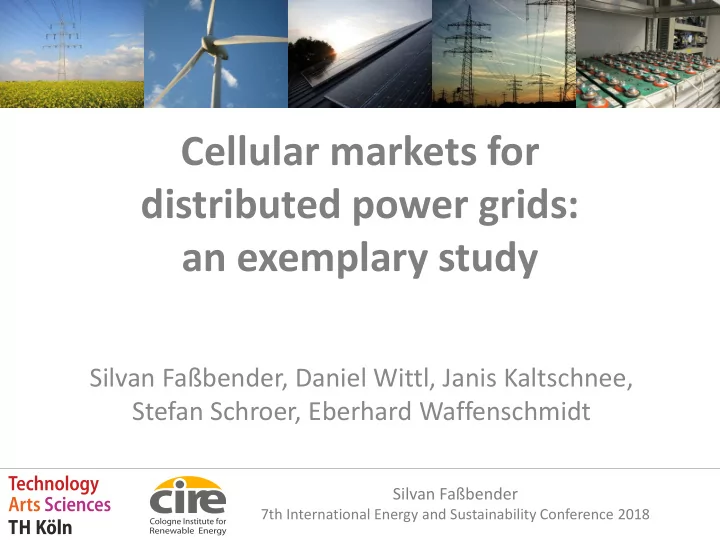

Cellular markets for distributed power grids: an exemplary study Silvan Faßbender, Daniel Wittl, Janis Kaltschnee, Stefan Schroer, Eberhard Waffenschmidt Silvan Faßbender 7th International Energy and Sustainability Conference 2018
Challenge and Objective Increasing volatility between electricity generation and consumption induce more and more transmission bottlenecks Conventional approach: ● Avoid them by building new transmission lines Our approach: ● exploit distributed nature of renewables ● Avoid and control transmission bottlenecks • primarily in the lowest grid level as possible in the distribution grid and • secondarily in the transmission grid ● Create a resilient System based on stable subsystems 2 Silvan Faßbender 7th International Energy and Sustainability Conference 2018
The cellular approach Distributed energy management systems (automation) ● Design of an active distribution network Each cell ● primarily supplies itself ● secondarily use transmission to supply next higher cell level Open question: ● How to orchestrate cells? 3 Silvan Faßbender 7th International Energy and Sustainability Conference 2018
Market solution How could cellular energy markets work? ● How can the cellular behaviour be illustrated? ● Which market tools could affect which parameters? Identify Parameters that indicate the utility of certain measures 4 Silvan Faßbender 7th International Energy and Sustainability Conference 2018
Market solution Organize and control via free market ● How could such market look like? Ideas: ● Automated pricing by a merit order ● Differentiation of transmission distance • Transmission fee or local bonus 5 Silvan Faßbender 7th International Energy and Sustainability Conference 2018
Merit Order Increasing Supply list Decreasing demand list Market clearing price 6 Silvan Faßbender 7th International Energy and Sustainability Conference 2018
Cellular Merit Order markets Cells are vertically linked Merit Order is linked to its upper and lower Merit Orders ● Transmission Capacities Cap(t) Each Cell has its own market clearing price ● Transmission Costs/Fees TC(t) Cell D MCP(t) Cap(t) Cap(t) TC(t) TC(t) Cell E Cell C MCP(t) MCP(t) Cap(t) Cap(t) Cap(t) Cap(t) TC(t) TC(t) TC(t) TC(t) Cell F Cell G Cell B Cell A MCP(t) MCP(t) MCP(t) MCP(t) 7 Silvan Faßbender 7th International Energy and Sustainability Conference 2018
Simulation Tool … Cell X Class „ Cell “ ● Properties: • Transmission capacity to neighboring cells Cell D • Own market price ● Functions: • Create Merit order Cell Cell • Calculate market clearing price E C Cells only vertically linked ● Hierarchy can be enhanced as far as desired Cell Cell Cell Cell Inputs: load and price profiles F G B A 8 Silvan Faßbender 7th International Energy and Sustainability Conference 2018
Simulation example Greater Cell which comprise of 5 small cells A, B, C, D, E Superior All Cells contain suppliers Grid and consumers, e.g.: ● Wind park + storage Greater Cell ● City + CHP plant ● Industry + biogas plant Cell Cell Cell Cell Cell ● Village + PV plants A B C D E 9 Silvan Faßbender 7th International Energy and Sustainability Conference 2018
Merit Order of Greater Cell Case 1: supply surplus Cells C & D (e.g. Cities) and the superior grid are supplied by Cell A & E (e.g. Wind & PV park) Superior C C D Grid Superior D Grid E E A A 10 Silvan Faßbender 7th International Energy and Sustainability Conference 2018
Merit Order of Greater Cell Different dates: supply deficit Cells C & D (e.g. Cities) are supplied by Cell A & E (e.g. Wind & PV park), the superior grid and Cell D partly by itself (CHP plant) C C Superior Superior D D D Grid Grid A E E A 11 Silvan Faßbender 7th International Energy and Sustainability Conference 2018
Fee or bonus on foreign cell trade Greater Cell: ● Own subcells: A, B, C, D, E ● Foreign trade with superior grid Fee on supply Bonus on supply Superior Fee on demand Grid Bonus on demand Superior Superior Superior Superior C C C C C C C C C C Grid D D D D D Grid Grid Grid Superior Superior Superior D D D D D Grid Grid Grid E E E E E E E E E E Superior Superior Superior A A A A A A A A A A Grid Grid Grid 12 Silvan Faßbender 7th International Energy and Sustainability Conference 2018
Conclusion Target: Cell gets more dependent on its own resources ● Introduce fees on foreign trade • Storages, flexible generators, demand response are utilized • Renewable supply is used directly • Superior cells get less stressed Target: Cell gets more dependent on external resources ● Introduce bonus on foreign trade • Supply surpluses can be exported • Supply deficits can be covered • Superior cells get more stressed Cellular markets could foster the appropriate installation of ● renewable power plants, ● storages and ● grid extensions 13 Silvan Faßbender 7th International Energy and Sustainability Conference 2018
Thank you for listening Contact: Silvan Faßbender, M. Sc. CIRE - Cologne Institute for Renewable Energy Cologne University of Applied Sciences Betzdorferstraße 2, 50679 Köln, silvan.fassbender@th-koeln.de www.th-koeln.de/personen/silvan.fassbender/ 14 Silvan Faßbender 7th International Energy and Sustainability Conference 2018
Recommend
More recommend